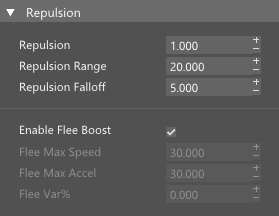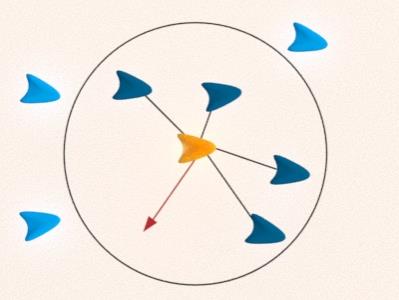swarm

This node can simulate behavior of fish schools, flocking of birds or swarms.
[Inputs]
#Particle Stream - This pin requires a particle stream to be connected. Connection is usually not required if any of the attributes is connected.
Enabled - Enable or disable node evaluation.
#Attract Pos - Attraction position.
#Repulse Pos - Repulse position.
Attraction

Attraction - Determines the strength at which all particles will be attracted to the closest attract position defined with the #Attract Pos pin.
Attraction Range - If particle is within the Attraction Range distance from the Attract Position, it will be attracted at maximum strength.
Attraction Range Falloff - Defines an area in which Attraction strength fades from maximum to zero.
Repulsion

Repulsion - Determines the strength at which all particles will be repulsed from the closes repulse position defined with Repulse Pos pin.
Repulsion Range - If particle is within the Repulsion Range distance from the Repulse Position, it will be repelled at maximum strength.
Repulsion Range Falloff - Defines an area in which Repulsion strength fades from maximum to zero.
Enable Flee Boost - Allows physical limitation change when particle is within the repulsion range from the Repluse Pos (including range falloff). Birds or fishes don`t cruise at maximum speed, but rather at an optimal level that conserves energy. Once they become hunted their energy output rises to the maximum level and their performance reaches maximum. This option will become active if system detect that the particle becomes hunted by the "repulsive force" and physical limitations values will get a boost.
Flee Max Speed - Temporary Maximum particle speed. Option is available only when Repulsion Pos pin is connected.
Flee Max Accel - Temporary Maximum particle accleration. Option is available only when Repulsion Pos pin is connected.
Flee Var% - Per-particle variation of the Flee Values.
Physical Limitations

Each species has its own distinct physical limitation. Small fish or birds can change direction much faster than a shark or albatross. At the same time smaller species has lower top speed. You can change those properties based on the particle scale or particle mass for example to achieve realistic simulations.
Max Speed - The maximum speed particle can achieve.
Max Acceleration - The maximum acceleration particle can gain.
Max Dir Change - Determines how fast the particle can change direction. Use smaller values for smaller species like sparrows or crickets and larger for sharks or large birds..
Swarm Behavior

Parameters within this dialog describes how each particle will interact with their neighbours. Result of these rules and interactions mimics collective animal behavior.
Visual Range - Swarm particles inside this range will influence particle collective behavior.
Blind Spot - Blind spot angle which is placed in the direction opposite of particle velocity.
Cohesion - The force that attracts individual particle to the center of its local swarm. Too high value can cause jittery motion.
Cohesion Var % - Cohesion variation.
Separation Distance - The distance at which the particle will start to get away from its closest neighbour.
Separation - The force strength that will try to separate particle from the neighbour particle group.Too high value can cause jittery motion
Separation Var % - Separation variation.
Alignment - Determines the strength at which the particle will inherit direction of its local flock.
Alignment Var % - Alignment variation.
Seed -.Random number generator seed. Change this value to get different pattern.
|
|
|
|
|
Cohesion |
Separation |
Alignment |


